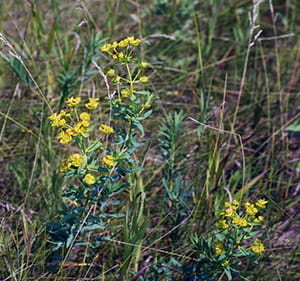By Brett Gaube, AAg, Range Management Extension Specialist, Weyburn
April 2024
Every year, Saskatchewan ranchers and farmers have to deal with weeds. Weeds cause numerous problems that negatively impact rangeland and all that live off the land. Weeds greatly affect profitability for farmers or ranchers due to yield loss and management costs. It is important to take time to plan, address and monitor any weed issues.
Example of invasive weeds are: Leafy spurge (Euphorbia esula) , Canada thistle (Cirsium arvense), nodding thistle (Carduus nutans) and common burdock (Arctium minus), which are designated as noxious weed species.
Some of the negative impacts of weeds include:
- growth of unpalatable forage (providing limited or no weight gains) and damage to livestock (causing scours, weakness and occasionally even death),
- a reduction in carrying capacity, and
- deterioration of the rangeland longevity.
There are many techniques that can be used to manage invasive weeds. Start by regularly monitoring the rangeland to spot weeds or weed patches when they first appear. Weed control is most effective when only a few plants are present—as the area grows it becomes harder to get under control.
Herbicides are also an effective control but can be costly. The timing of the application is important because it impacts the herbicide's effectiveness. The Guide to Crop Protection provides advice for using chemical control options. For example, it is important to spray at least a five metre buffer around the visible perimeter of the affected patch to control the spread and development of new weeds. No single chemical treatment will eradicate or properly control an infestation; therefore, monitoring the treated area is critical to determine follow up actions.

Mowing is a viable management method on its own, or in sequence with another technique. The timing of mowing is essential for its success as it should be completed when the weeds are in their early flowering stages. Mowing after the completed flowering stage will increase the risks associated with spreading the weed’s seeds. A follow-up mowing treatment may be necessary two weeks after the initial mow to control any regrowth.
Biological controls such as beetles and multi-species grazing, including goats and sheep, can also be used on specific weeds such as leafy spurge. Beetles control the spurge invasion by adults eating the leaves and its larvae attacking the plant’s root system causing the spurge stress. The damage caused by the flea beetles also makes the plant more susceptible to other control methods.
Weed management is best done through prevention. Take care to avoid introducing weed species by cleaning your equipment and being cautious about where you buy feed from. Actively monitor rangeland to detect and eradicate newly established invasive weed species early, as it becomes very difficult to contain and control invasive weed once they’ve become well established.
Funding for options to target invasive weeds is available through the Resilient Agricultural Landscapes Program under the Targeted Grazing Beneficial Management Practice. For more information on this program or others offered through the Sustainable Canadian Agricultural Partnership, contact your local agri-environmental specialist.
